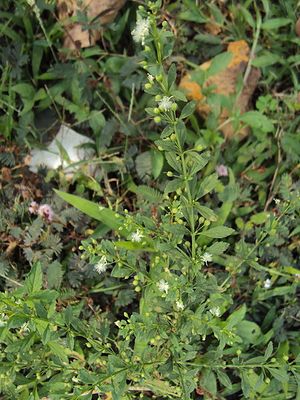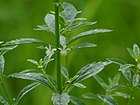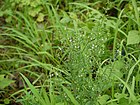Note: This is a project under development. The articles on this wiki are just being initiated and broadly incomplete. You can Help creating new pages.
Scoparia dulcis - Sweet Broom Weed
Scoparia dulcis is a species of flowering plant in the plantain family and It is native to the Neotropics but it can be found throughout the tropical and subtropical world.
Uses
Gastralgia, Dysentery, Intestinal affections, Fever, Enteritis, Beriberi, Swelling, Diarrhea, Cough, Kidney complaints, Indigestion, Colic[1]
Parts Used
Chemical Composition
Palmitic acid, B-sitosterol, Glutinol, and a mixture of B-amyrin and Isomultiflorenol[3]
Common names
| Language | Common name |
|---|---|
| Kannada | Manitumbe gida |
| Hindi | Mithi patti, Jaldaniya |
| Malayalam | |
| Tamil | Sarakkotthini |
| Telugu | POttiboli |
| Marathi | NA |
| Gujarathi | NA |
| Punjabi | NA |
| Kashmiri | NA |
| Sanskrit | |
| English | Sweet Broom Weed, Sweet Broom Wort |
Properties
Reference: Dravya - Substance, Rasa - Taste, Guna - Qualities, Veerya - Potency, Vipaka - Post-digesion effect, Karma - Pharmacological activity, Prabhava - Therepeutics.
Dravya
Rasa
Tikta (Bitter), Kashaya (Astringent)
Guna
Laghu (Light), Ruksha (Dry), Tikshna (Sharp)
Veerya
Ushna (Hot)
Vipaka
Katu (Pungent)
Karma
Kapha, Vata
Prabhava
Habit
Identification
Leaf
| Kind | Shape | Feature |
|---|---|---|
| Simple | Oblong-elliptic | Leaf Arrangement is Decussate or whorled |
Flower
| Type | Size | Color and composition | Stamen | More information |
|---|---|---|---|---|
| Unisexual | 2-4cm long | white | 5 | Flowers are Solitary or 2, axillary and Flowering throughout the year. Flowering from May to October |
Fruit
| Type | Size | Mass | Appearance | Seeds | More information |
|---|---|---|---|---|---|
| ellipsoid | 7–10 mm | Fruit are globose capsule and Fruiting throughout the year | Septicidal, Reticulate | Fruiting from May to October |
Other features
List of Ayurvedic medicine in which the herb is used
Where to get the saplings
Mode of Propagation
How to plant/cultivate
A common weed of lowland tropical and subtropical areas, found in areas where it rains all year round and also where there is a prolonged dry season[310 ]. Succeeds in most soils[5]
Commonly seen growing in areas
Photo Gallery
References
- ↑ Karnataka Medicinal Plants Volume - 2 by Dr.M. R. Gurudeva, Page No.585
- ↑ 2.0 2.1 "Karnataka Medicinal Plants Volume - 2" by Dr.M. R. Gurudeva, Page No.584, Published by Divyachandra Prakashana, #45, Paapannana Tota, 1st Main road, Basaveshwara Nagara, Bengaluru.
- ↑ Chemical constituents
- ↑ Morphology
- ↑ Cultivation details
External Links
- Ayurvedic Herbs known to be helpful to treat Gastralgia
- Ayurvedic Herbs known to be helpful to treat Dysentery
- Ayurvedic Herbs known to be helpful to treat Intestinal affections
- Ayurvedic Herbs known to be helpful to treat Fever
- Ayurvedic Herbs known to be helpful to treat Enteritis
- Ayurvedic Herbs known to be helpful to treat Beriberi
- Ayurvedic Herbs known to be helpful to treat Swelling
- Ayurvedic Herbs known to be helpful to treat Diarrhea
- Ayurvedic Herbs known to be helpful to treat Cough
- Ayurvedic Herbs known to be helpful to treat Kidney complaints
- Ayurvedic Herbs known to be helpful to treat Indigestion
- Ayurvedic Herbs known to be helpful to treat Colic
- Herbs with Leaf used in medicine
- Herbs with common name in Kannada
- Herbs with common name in Hindi
- Herbs with common name in Tamil
- Herbs with common name in Telugu
- Herbs with common name in English
- Habit - Annual plant
- Index of Plants which can be propagated by Seeds
- Herbs that are commonly seen in the region of Subtropical area
- Herbs that are commonly seen in the region of Tropical area
- Herbs
- Plantaginaceae





